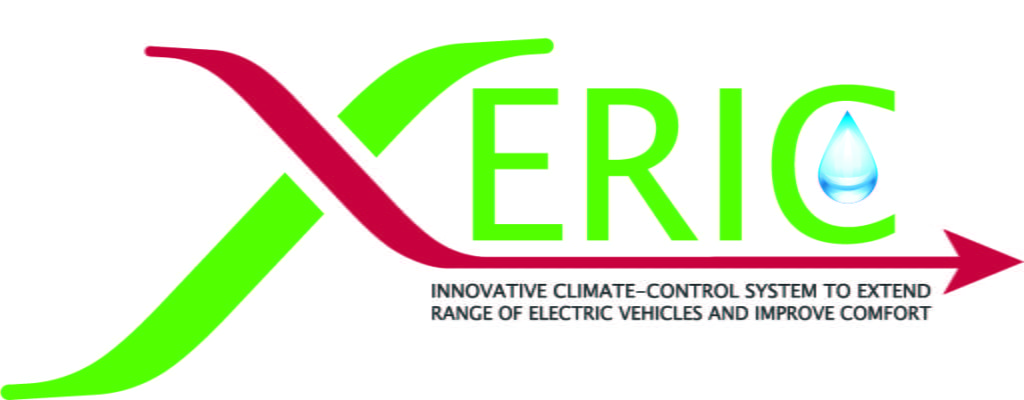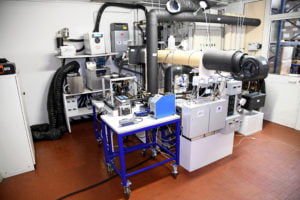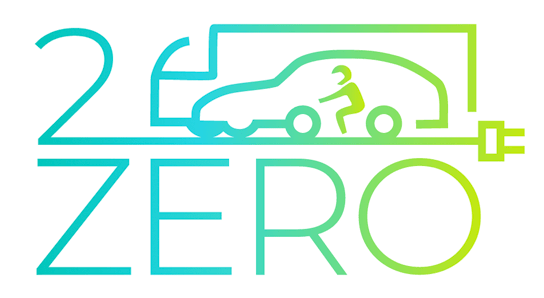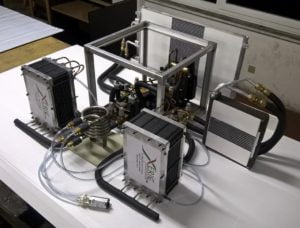XERIC

- Website: http://xeric.eu/
An energy-friendly Climate Control System successfully developed
A substantial amount of energy is required currently to run auxiliary systems within electric vehicles, which is a major drain on the battery and so limits the range of the car. The core goal achieved by XERIC has been to develop an energy-friendly climate-control system (CCS) capable of both assuring passenger comfort and increasing the range of electric vehicles. At the heart of this system, there is a new-type three-phase membrane contactor.
Key results & deliverables available since June 2018:
- Small-scale prototype of the entire XERIC CCS (TRL6): The XERIC CCS combines a liquid desiccant cycle with a traditional vapour compression cycle.
- Small-scale prototype of 3-fluids combined membrane contactor (3F-CMC), part of the XERIC CCS (TRL6): Prototype of an innovative and highly compact component, working simultaneously with air, desiccant solution and refrigerant thanks to the superposition of elementary modules: the refrigerant flows inside mini-tubes, providing space outside the tubes and between two membrane sheets for the flow of the desiccant solution. The air flows on the other side of membranes in cross-flow respect to desiccant and refrigerant.
- Modelling tools (TRL3): to predict, through modelling, the performance of the entire CCS as well as3F-CMC (initially in Fortran, then in Matlab).
- Environmental impact and economic feasibility of the CCS prototype(n.a.)
- Hydrophobic membranes (TRL6): PTFE and PVDF hydrophobic membranes developed and optimised (average pore size: 0.2 μm)
- Innovative (for the automotive sector) electronic control system (TRL6): Electronic control system based on a variable frequency drive compressor and a brushless direct current motor characterised by a system efficiency in the range 85-95%.
Working prototypes ready to be modulated for the market
Starting from the experimental proof of concept (TRL3), XERIC partners have successfully demonstrated the performance of the XERIC innovative technology in a climatic chamber replicating industrially relevant environment conditions (TRL6). This result goes above the initial ambitious objective set for XERIC, which was TRL4 (technology validated in lab).
The prototype of the XERIC innovative CCS has been designed, manufactured and successfully tested under various external air temperatures ranges:
- in heating mode, from -10 to 10 °C, but there is no technical reason for the heat pump not to work in the temperature range [-20 °C, +15 °C]
- in cooling/dehumidification mode, from 20 °C to 45 °C.
The XERIC CCS is capable to reduce:
- slightly more than 50% the energy used for passenger comfort throughout the year (i.e., air heating, cooling and dehumidifying) compared to existing systems that rely on electric direct heating in wintertime;
- up to 32,9 % the energy used for air cooling/dehumidifying in extreme summer conditions (i.e., external air at T=30 °C and RH=60 %) to guarantee comfort in the passenger cabin (i.e., T≈25 °C and RH≈50 %).
In particular, the innovative 3F-CMC created is capable of cooling/dehumidifying 67 m3/h of external air at T = 30°C and RH = 60%. It has proven capable of extracting from the air at least 0.4 kg/h of water vapour with an air pressure drop lower than 100 Pa.
The cost analysis showed an industrial cost of Euro 1542 (renewal air 200m3/h) which could be sold to Original Equipment Manufacturers (OEMs) at about Euro 3000.
The working prototypes are now ready to be modulated according to the market needs (i.e. capacity, size). XERIC partners are exploring industrial partnership opportunities and particularly with OEM and tier-one suppliers to tailor the XERIC innovative system. The modularity of the 3F-CMC helps in tailoring the component size to the required one, provided that the base element is the same (i.e., the height of the component can be easily customised). The miniaturisation of the system is foreseen with the help of tier-one suppliers and OEMs working in the EV market in order to ensure that the present size of the CCS can fit in the space available in EVs currently on the market.
More about the innovative xeric technology
The technology developed is based on a hybrid system, combining a liquid desiccant cycle (operating on humidity) with a traditional vapour compression cycle (VCC, dealing with temperature). Whereas a traditional CCS condenses water, in the XERIC system water is effectively taken away thanks to an innovative and highly compact three-fluid-combined membrane contactor (3F-CMC) that works simultaneously with air, desiccant solution and refrigerant. The humidity in the air is captured at the membrane interface, so dry air is circulated in the car. This reduces the amount of energy required for the battery to dehumidify the air. A few pictures follow:
 Illustration 1: Testing of the entire XERIC CCS in the climatic chamber (TRL6). FRIGOMAR |
Illustration 2: Prototypes of the 3F-CMCs |
|
|
Impacts and applications of XERIC results: who will benefit from XERIC? What about the effects on climate change?
Although the XERIC breakthrough technologies were developed and tuned especially for expanding the EVs range, their innovative potential is far beyond this particular application. The system is also profitable for improving air-conditioning in traditional vehicles, equipped with an internal combustion engine: it allows reducing fuel consumption and related air pollution. In the same way, the XERIC system can be conveniently adopted on trucks, buses, and trams, trains, caravans, boats. The system could also be applied in other situations where humidity needs to be removed from the air; e.g. in civil buildings, hospitals, and industries (refrigerated rooms).
The main challenges tackled by XERIC are technological but also environmental and economic. With its innovative system, XERIC aims to enable the market uptake of electric vehicles and boost usage of EVs, reducing dependence on fossil fuels and related air pollution. Industrials specialised in the EV domain stressed the fact that such technology is answering to the market requirements also because the way of thinking “transport” is changing. Thinking “energy efficiency” is a more common and integrated way of thinking for public authorities and for end-users who are becoming more and more conscious of global warming. An innovative and energy-efficient CCS, such as the XERIC system, is crucial nowadays in the sense that it optimises the energy consumption taking into account passenger comfort.
By taking Germany and Italy as reference scenarios, the results indicate that in Germany the average reduction in environmental burden is around 40 % in four impact categories: Climate change, Terrestrial Acidification, Photochemical Oxidant Formation, and Freshwater Eutrophication. In Italy, reduction in environmental burden ranges between 41 % and 29 %.
Energy efficiency for EV: a cluster of three H2020 projects
XERIC invited two other European projects working on the second topic of the call “Green Vehicles” – Optimised and systematic energy management in electric vehicles – to cluster and share their dynamics. XERIC, JOSPEL and OPTEMUS started holding joint activities in fall 2015 and come up with at least 15 solutions, already developed or under development, to meet the challenge of “Energy efficiency for electric vehicles”. These clustering activities led to various partner meetings, the joint organisation of 4 workshops and the joint participation in a CDB project (Common Dissemination Booster: a new free service offered by the European Commission to support the diffusion of the results obtained by the best projects).
For more information on XERIC, JOSPEL and OPTEMUS, download the Project Portfolio EGVI (European Green Vehicles Initiative) cPPP .




